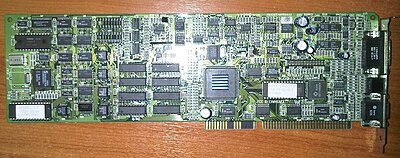
Video Graphics Array (VGA) is a video display controller and accompanying de facto graphics standard, first introduced with the IBM PS/2 line of computers in 1987, which became ubiquitous in the IBM PC compatible industry within three years. The term can now refer to the computer display standard, the 15-pin D-subminiature VGA connector, or the 640 × 480 resolution characteristic of the VGA hardware.

A graphics card is a computer expansion card that generates a feed of graphics output to a display device such as a monitor. Graphics cards are sometimes called discrete or dedicated graphics cards to emphasize their distinction to an integrated graphics processor on the motherboard or the central processing unit (CPU). A graphics processing unit (GPU) that performs the necessary computations is the main component in a graphics card, but the acronym "GPU" is sometimes also used to erroneously refer to the graphics card as a whole.

The Hercules Graphics Card (HGC) is a computer graphics controller formerly made by Hercules Computer Technology, Inc. that combines IBM's text-only MDA display standard with a bitmapped graphics mode, also offering a parallel printer port. This allows the HGC to offer both high-quality text and graphics from a single card.

The Enhanced Graphics Adapter (EGA) is an IBM PC graphics adapter and de facto computer display standard from 1984 that superseded the CGA standard introduced with the original IBM PC, and was itself superseded by the VGA standard in 1987. In addition to the original EGA card manufactured by IBM, many compatible third-party cards were manufactured, and EGA graphics modes continued to be supported by VGA and later standards.

ATI Technologies Inc., commonly called ATI, was a Canadian semiconductor technology corporation based in Markham, Ontario, that specialized in the development of graphics processing units and chipsets. Founded in 1985, the company listed publicly in 1993 and was acquired by AMD in 2006. As a major fabrication-less or fabless semiconductor company, ATI conducted research and development in-house and outsourced the manufacturing and assembly of its products. With the decline and eventual bankruptcy of 3dfx in 2000, ATI and its chief rival Nvidia emerged as the two dominant players in the graphics processors industry, eventually forcing other manufacturers into niche roles.

The Amstrad PC1512 was Amstrad's mostly IBM PC-compatible computer system, first manufactured in 1986. Next year a slight updated version named PC1640 was introduced. It was also marketed as PC6400, and Sinclair PC500. Schneider branded machines for the German market also exists.

Chips and Technologies, Inc. (C&T), was an early fabless semiconductor company founded in Milpitas, California, in December 1984 by Gordon A. Campbell and Dado Banatao.

The GeForce 6 series is the sixth generation of Nvidia's GeForce line of graphics processing units. Launched on April 14, 2004, the GeForce 6 family introduced PureVideo post-processing for video, SLI technology, and Shader Model 3.0 support.

The Monochrome Display Adapter is IBM's standard video display card and computer display standard for the IBM PC introduced in 1981. The MDA does not have any pixel-addressable graphics modes, only a single monochrome text mode which can display 80 columns by 25 lines of high-resolution text characters or symbols useful for drawing forms.

Tseng Laboratories, Inc. was a maker of graphics chips and controllers for IBM PC compatibles, based in Newtown, Pennsylvania, and founded by Jack Hsiao Nan Tseng.

The Tseng Labs ET4000 was a line of SVGA graphics controller chips during the early 1990s, commonly found in many 386/486 and compatible systems, with some models, notably the ET4000/W32 and later chips, offering graphics acceleration. Offering above average host interface throughput coupled with a moderate price, Tseng Labs' ET4000 chipset family were well regarded for their performance, and were integrated into many companies' lineups, notably with Hercules' Dynamite series, the Diamond Stealth 32 and several Speedstar cards, and on many generic boards.

AMD CrossFire is a brand name for the multi-GPU technology by Advanced Micro Devices, originally developed by ATI Technologies. The technology allows up to four GPUs to be used in a single computer to improve graphics performance.

Oak Technology (OAKT) was an American supplier of semiconductor chips for sound cards, graphics cards and optical storage devices such as CD-ROM, CD-RW and DVD. It achieved success with optical storage chips and its stock price increased substantially around the time of the tech bubble in 2000. After falling on hard times, in 2003 it was acquired by Zoran Corporation.

Video BIOS is the BIOS of a graphics card in a computer. It initializes the graphics card at the computer's boot time. It also implements INT 10h interrupt and VESA BIOS Extensions (VBE) for basic text and videomode output before a specific video driver is loaded. In UEFI 2.x systems, the INT 10h and the VBE are replaced by the UEFI GOP.

Rendition, Inc., was a maker of 3D computer graphics chipsets in the mid to late 1990s. They were known for products such as the Vérité 1000 and Vérité 2x00 and for being one of the first 3D chipset makers to directly work with Quake developer John Carmack to make a hardware-accelerated version of the game (vQuake). Rendition's major competitor at the time was 3Dfx. Their proprietary rendering APIs were Speedy3D and RRedline.

The Plantronics Colorplus is a graphics card for IBM PC computers, first sold in 1982. It implements a superset of the then-current CGA standard, using the same monitor standard and providing the same pixel resolutions. It was produced by Frederick Electronics, a subsidiary of Plantronics since 1968, and sold by Plantronics' Enhanced Graphics Products division.
The ATI Mach line was a series of 2D graphics accelerators for personal computers developed by ATI Technologies. It became an extension to the ATI Wonder series of cards. The first chip in the series was the ATI Mach8. It was essentially a clone of the IBM 8514/A with a few notable extensions such as Crystal fonts. Being one of the first graphics accelerator chips on the market, the Mach8 did not have an integrated VGA core. In order to use the first Mach8 coprocessor cards, a separate VGA card was required. This increased the cost of ownership as one had to purchase two rather than one expansion card for graphics. A temporary solution was presented with the ATI Graphics Ultra/Vantage cards, which combined an ATI 8514 Ultra and VGA Wonder+ into a single card. The Mach32 chip was the follow-up to the Mach8, which finally featured an integrated VGA core, true colour support and a 64-bit datapath to internal memory.
The All-in-Wonder was a combination graphics card/TV tuner card designed by ATI Technologies. It was introduced on November 11, 1996. ATI had previously used the Wonder trademark on other graphics cards, however, they were not full TV/graphics combo cards. ATI also made other TV oriented cards that use the word Wonder, and remote control. The All-in-Wonder line debuted with the Rage chipset series. The cards were available in two forms, built by third-party manufacturers as well as by ATI itself.

The Voodoo2 is a set of three specialized 3D graphics chips on a single chipset setup, made by 3dfx. It was released in February 1998 as a replacement for the original Voodoo Graphics chipset. The card runs at a chipset clock rate of 90 MHz and uses 100 MHz EDO DRAM, and is available for the PCI interface. The Voodoo2 comes in two models, one with 8 MB RAM and one with 12 MB RAM. The 8 MB card has 2 MB of memory per texture mapping unit (TMU) vs. 4 MB on the 12 MB model. The 4 MB framebuffer on both cards support a maximum screen resolution of 800 × 600, while the increased texture memory on the 12 MB card allows more detailed textures. Some boards with 8 MB can be upgraded to 12 MB with an additional daughter board.

Tandy Graphics Adapter is a computer display standard for the Tandy 1000 series of IBM PC compatibles, which has compatibility with the video subsystem of the IBM PCjr but became a standard in its own right.

























